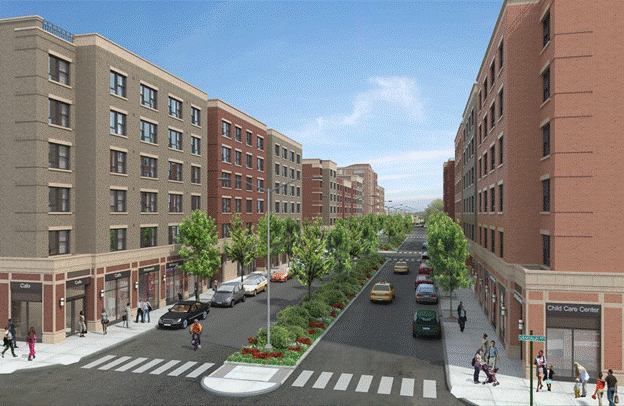
(NYC HDC rendering)
For more than a year there has been wrangling and discord among developers, housing advocates, organized labor, and our elected leaders over an agreement on spending for affordable housing. A “memorandum of understanding” was drafted, but a budget and legislative session came and went in Albany without a consensus.
Now, we finally have a state budget that gives us more than $2 billion in spending on housing. It will have its critics, but by and large this plan puts in front of us the resources and the political will to address the housing and community revitalization needs of cities large and small throughout New York.
This commitment of state resources is more critical than ever as we face a hostile federal budget that aims to eliminate housing programs that are integral to everyday New Yorkers, as well as those that provide safety nets and services to our most vulnerable citizens.
At The Community Preservation Corporation (CPC), small buildings have been our focus for more than four decades. What we’ve seen across our lending portfolio highlights the critical role they play in the stability of our neighborhoods, but also the challenges these properties face. They are where most low- and moderate-income renters live, and are an essential resource of natural affordability.
The state’s housing plan puts in place more than $60 million to help preserve this irreplaceable, yet often forgotten backbone of our housing stock.
Seventy-one percent of the multifamily buildings in the upstate markets CPC serves have fewer than 50 units. What’s striking is that 67 percent of units in these small buildings are in fair or poor condition. They tend to be older, more distressed, and their owners often lack the means to maintain their physical and financial health.
Why are they so important? The rents in these very same buildings are the most affordable in all markets. They are 16 percent below the average rent for their metro areas and 40 percent below the rent levels of the highest-quality buildings. State resources on this scale will be key in preserving and improving housing that is currently serving millions of New Yorkers, and ensuring that it will continue to serve millions more well into the future.
Supportive housing is one of the most compassionate, effective, and cost-efficient means to addressing homelessness. Section 8 has played a significant role in its funding, but with the program squarely in the crosshairs of the president’s budget, state funding will be key to continuing its production.
This deeply affordable housing provides stability and supportive services specifically tailored to the needs of at-risk populations such as formerly homeless military veterans, youth aging out of foster care, and those with mental illness who need additional support.
A joint report by New York City and State found that tenants of supportive housing spent fewer days in jail, homeless shelters, and state-operated psychiatric facilities. This can save taxpayers millions because these tenants are far less likely to need other publicly-funded programs such as government-subsidized health care and social services.
Governor Cuomo’s “Affordable New York” program, which replaces 421-a, will help jumpstart development of low- and moderate-income rental housing in working-class communities throughout New York City’s boroughs. This is essential in a city like New York where half of renters are rent-burdened – paying 30 percent or more of their income towards rent.
Contrary to the spotlight on luxury buildings in high-market neighborhoods, data shows that more than 64 percent of all residential units financed under the old 421-a program between 2010-2015 were created outside of Manhattan, most in smaller buildings.
Thousands of units of affordable and naturally affordable housing would not have been financially feasible and would not have been built without 421-a. Those properties are anchoring working-class communities, providing revenue to the city, and their construction, operation, and maintenance create jobs.
This plan makes good on the governor’s promise to provide an unprecedented level of state resources to address the housing challenges facing our state. It is time for the housing community to come together and recognize that we’re all on the same team. The federal budget, or lack thereof, is looming large over our efforts to strengthen our communities and serve those most in need. If we continue to fracture and fight amongst ourselves, the losers will be the New Yorkers who don’t have the luxury of waiting for us to get out of our own way.
***
Rafael E. Cestero is the president and CEO of The Community Preservation Corporation and former commissioner of the New York City Department of Housing Preservation and Development. On Twitter @communityp.
***
Have an op-ed idea or submission for Gotham Gazette? Email This email address is being protected from spambots. You need JavaScript enabled to view it.